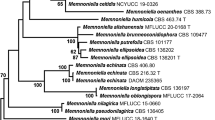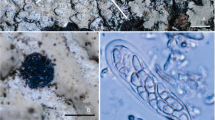Abstract
Diplococcium dimorphosporum sp. nov., D. racemosum sp. nov., D. singulare sp. nov. and D. pulneyense Subram. & Sekar collected from plant debris in natural areas of Spain are described and illustrated. The first species is characterized principally by the production of branched conidiophores and short chains of conidia. Diplococcium singulare has unbranched conidiophores, and conidia produced usually at the tip of conidiophores and from lateral spherical conidiogenous cells. In addition, both species develop a Selenosporella synanamorph with narrow falcate conidia. Diplococcium racemosum produces branched, verrucose conidiophores, and verrucose conidia in long branched chains. Diplococcium pulneyense is the second record, being described for first time on the natural substratum and re-described in pure culture. A key to currently accepted species of Diplococcium is provided.





Similar content being viewed by others
References
Braun U, Hosagoudar VB, Abraham TK (1996) Diplococcium atrovelutinum sp. nov. from India. New Botanist 23:1–4
Cruz ACR, Gusmão LFP, Leão-Ferreira SM, Castañeda-Ruiz RF (2007) Conidial fungi from the semi-arid Caatinga biome of Brazil. Diplococcium verruculosum sp. nov. and Lobatopedis longistriatum sp. nov. Mycotaxon 102:33–38
Goh TK, Hyde KD (1998) A synopsis of and a key to Diplococcium species, based on the literature, with a description of a new species. Fungal Divers 1:65–83
Kornerup A, Wanscher JH (1984) Methuen handbook of colour, 3rd edn. Eyre Methuen, London
Samuels GJ, Candoussau F, Magni J-F (1997) Fungicolous pyrenomycetes 1. Helminthosphaeria and the new family Helminthosphaeriaceae. Mycologia 89:141–155
Shenoy BD, Jeewon R, Hyde KD (2007) Impact of DNA sequence-data on the taxonomy of anamorphic fungi. Fungal Divers 26:1–54
Shenoy BD, Jeewon R, Wang H, Amandeep K, Ho WH, Bhat DJ, Crous PW, Hyde KD (2010) Sequence data reveals phylogenetic affinities of fungal anamorphs Bahusutrabeeja, Diplococcium, Natarajania, Paliphora, Polyschema, Rattania and Spadicoides. Fungal Divers 44:161–169
Shirouzu T, Harada Y (2008) Lignicolous dematiaceous hyphomycetes in Japan: five new records for Japanese mycoflora, and proposals of a new name, Helminthosporium magnisporum, and a new combination, Solicorynespora foveolata. Mycoscience 49:126–131
Subramanian CV (1983) Studies on Ascomycetes. Trans Br mycological Soc 81:313–332
Subramanian CV, Sekar G (1987) Three bitunicate ascomycetes and their tretic anamorphs. Kavaka 15:87–97
Villar L, Benito-Alonso JL (2006) Los bosques del Parque Nacional de Ordesa y Monte Perdido (Pirineo Central Español): cartografía, valor ecológico y conservación. Instituto Pirenaico de Ecología, CSIC. http://www.jolube.net/pub/articulos/NaturaliaMaroccana2.htm
Wang CJK, Sutton BC (1998) Diplococcium hughesii sp. nov. with a Selenosporella synanamorph. Can J Bot 76:1608–1613
Acknowledgements
We are grateful to Dr. David W. Minter (CABI,UK) for his critical review of the manuscript. This study was supported by the Spanish Ministerio de Ciencia y Tecnología, grant CGL 2008-04226.
Conflict of interest
The authors declare that they have no conflict of interest.
Author information
Authors and Affiliations
Corresponding author
Additional information
Taxonomical novelties. Diplococcium dimorphosporum M. Hern.-Rest., J. Mena, Gené & Guarro sp. nov., Diplococcium racemosum Silvera, Mercado, Gené & Guarro sp. nov., Diplococcium singulare M. Hern.-Rest., J. Mena, Gené & Guarro, sp. nov.
Rights and permissions
About this article
Cite this article
Hernández-Restrepo, M., Silvera-Simón, C., Mena-Portales, J. et al. Three new species and a new record of Diplococcium from plant debris in Spain. Mycol Progress 11, 191–199 (2012). https://doi.org/10.1007/s11557-011-0741-6
Received:
Revised:
Accepted:
Published:
Issue Date:
DOI: https://doi.org/10.1007/s11557-011-0741-6




